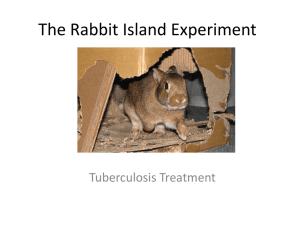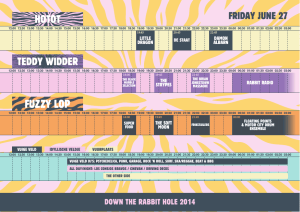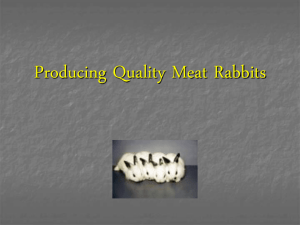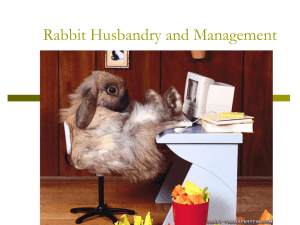determining various aspects of domesticating wild rabbit forages
advertisement
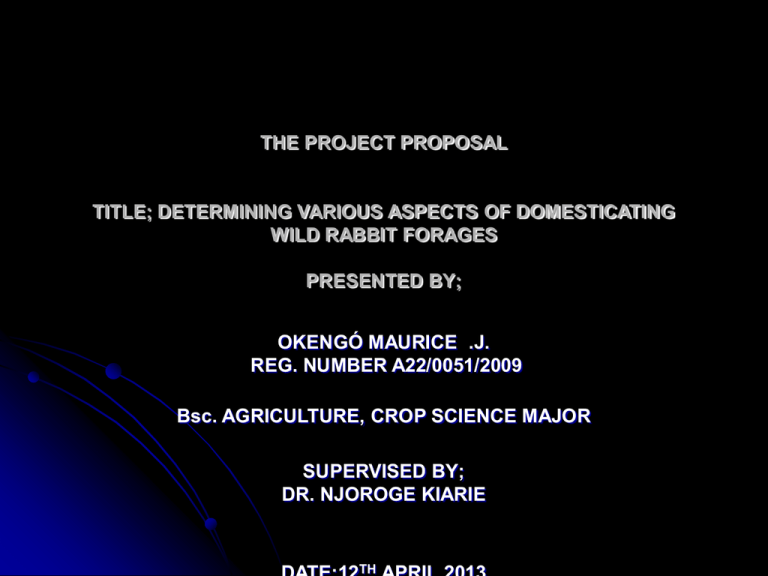
THE PROJECT PROPOSAL TITLE; DETERMINING VARIOUS ASPECTS OF DOMESTICATING WILD RABBIT FORAGES PRESENTED BY; OKENGÓ MAURICE .J. REG. NUMBER A22/0051/2009 Bsc. AGRICULTURE, CROP SCIENCE MAJOR SUPERVISED BY; DR. NJOROGE KIARIE TH INTRODUCTION There is need to increase food security in the country. Food production for many years has faced many challenges and consequently food prices have been escalating each day making it difficult for the majority of the Kenyan population to access essential nutrition especial the animal protein. In the recent past, most of the studies conducted in the country have pointed out the positive remedy to this crisis through rabbit meat production. The studies show a remarkable success and high potential in this sector. For a long time, rabbit keeping was seen as an activity for young boys who kept them as a hobby (MOLD, 2004). Rabbit production is gaining popularity throughout Kenya as an as an economic undertaking. this new hope could only be constrained by insufficient and unsustainable of the rabbit feed supply base. PROBLEM STATEMENT AND JUSTIFICATION There is need to increase the wild rabbit forages that can eventually be conserved to ensure constant and sustainable supply of rabbit feeds. This will simultaneously contribute positively into the value chain of rabbit meat production solving the problem of feed inadequacy will spun the production of the rabbit production to large scale and allow for the commercialisation of the feed handling, which in return could expand rabbit rearing. The problem of feed inadequacy of these wild forages is unavoidable because most of the areas in Kenya are affected by dry spell for a better part of the year which limits establishment of sufficient feeds. Also as part of the cultural cultivations the wild rabbit forages is eliminated as weed. Domestication of these forages thereby will tackle the problem of feed insufficiency by increasing the feed base supply. METHODOLOGY 3.1 Materials and requirements Black jack seeds Common Sowthistle seeds Wooden pegs Meter rule Gallant soldier seeds Phosphate (D.A.P) Nitrate (C.A.N) Pesticide (duduthrin) Tape measure 8.5m by 5.5m research plot. EXPERIMENT Treatments; 1. Treatment1 ……… the control. 2. Treatment2 ……….weeding only. 3. Treatment3 ……..weeding + pesticide only. 4. Treatment4 ………..weeding +pesticide + fertilizer. The experiment will be on 24 small plot divided into three blocks each with different forage. Each block has 4 treatment all replicated twice. Land preparation and planting done before the onset of the rain. After a period of 5-6 weeks the plant are harvested to measure the weight of randomly selected plants, these are used to obtain the average mean from each plot. CHAPTER FIVE: WORKPLAN AND SCHEDULE ACTIVITY Land preparation Seed collection Seedbed preparation Planting Germination data Top dressing Data recording DATE (2013) 10th January February February 12th march 30th march April 30th march - may Data analysis Report submission may may CHAPTER FIVE; WORKPLAN AND SCHEDULE activity Land preparation Seed collection Seedbed preparation Planting Germination data Top dressing Data recording Data analysis Report submission CHAPTER SIX; REFERENCES Wanyoike, M. ; BASELINE SURVEY REPORT “Project: Strategies to Promote Rabbit Value Chain in Kenya”. Widderick, M 2002 ;WEED 5;COMMON SOWTHISTLE Blackjack production guideline; Department of Agriculture, Forestry and Fisheries REPUBLIC OF SOUTH AFRICA Widderick, M 2002; Management of common sowthistle. G. J. H. Grubben 1996 Plant Resources of Tropical Africa: Vegetables (PROTA 2). Soyebo K.O. (2006) Constraints Against Widespread of Rabbit Keeping among Households in Osun and Oyo States: Implication for Family Economic Empowerment, Journal of Applied Sciences Research Vietmeyer, N. D. 1985. Potentials of micro livestock in developing countries. J. Appl. Rabbit Res. 8:10. Ministry of Livestock Development (2004). Annual Report, Department of Livestock Production. Nairobi: Ministry of Livestock. McNitt, J. I., Patton, N. M., Lukefahr, S. D. and Cheeke, P. R.2000. Rabbit Production. 8th ed. Interstate Printers and Publishers, Danville, I Lukefahr, S. D. (1998). Rabbit production in Uganda: Potential versus opportunity. World Rabbit Science, 6(3-4). Gebremedhin T.G. (1991) The economics of small-scale rabbit production, American Journal of Alternative Agriculture (1991), 6 : pp 180-183 Widderick, M. (2002). Common Sowthistle – Understanding its Ecology is the Key to Better Management. Extension Brochure, Queensland Department of Primary Industries and Fisheries. Cheeke P. R. (1986) Potentials of rabbit production in tropical and subtropical agricultural systems. Journal of Animal Science. Volume 63:1581-1586 Yono C, Raharj C, Cheeke PR and Patton NM (1986). Growth and reproductive performance of rabbits on a moderately low crude protein diet with or without methionine or urea supplementation. THANK YOU!






